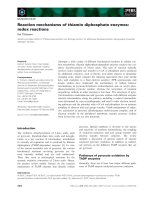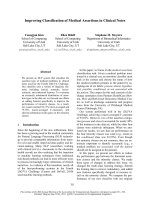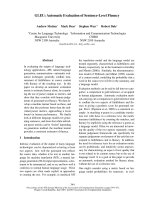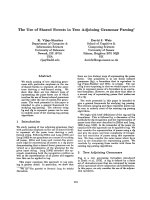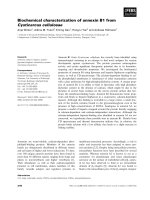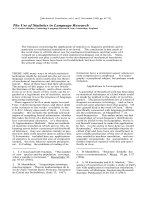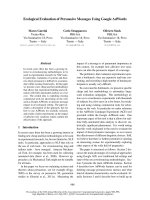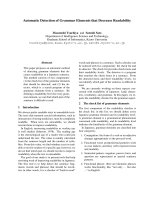Báo cáo khoa học: "The use of crossreactive monoclonal antibodies to characterize the immune system of the water buffalo (Bubalus bubalis)" pdf
Bạn đang xem bản rút gọn của tài liệu. Xem và tải ngay bản đầy đủ của tài liệu tại đây (34.83 KB, 7 trang )
-2851$/ 2)
9HWHULQDU\
6FLHQFH
J. Vet. Sci. (2001),G2(2), 103–109
The use of crossreactive monoclonal antibodies to characterize the
immune system of the water buffalo (Bubalus bubalis)
W. C. Davis*, A. M. Khalid
1
, M. J. Hamilton, J. S. Ahn, Y. H. Park
2
and G. H. Cantor
Department of Veterinary Microbiology and Pathology, College of Veterinary Medicine, Washington State University,
Pullman, WA 99164-7040, USA
1
Department of Microbiology, Moshtohor, Zagazig University, Benha Branch, Kalioba, Egypt
2
Department of Microbiology, College of Veterinary Medicine and School of Agricultural Biotechnology,
Seoul National University, Suwon 441-744, Korea
One of the major difficulties in studying the
mechanisms of host defense in economically important
species indigenous to Asia and the Middle East is the lack
of monoclonal antibody (mAb) reagents that define the
immune systems of species other than cattle, goats, sheep,
and pigs. One strategy that could obviate this problem at
minimal cost is to identify existing mAbs that recognize
conserved epitopes on orthologous major
histocompatibility complex (MHC) and leukocyte
differentiation molecules. To explore the potential of this
approach, we screened a large set of mAbs that recognize
bovine MHC class I and II molecules and leukocyte
differentiation molecules to identify mAbs that react with
orthologous molecules in water buffalo. One hundred
thirty eight were found that recognize conserved
determinants on orthologous molecules. In addition to
identifying a useful set of reagents, the study has provided
insight into the composition of the immune system of the
water buffalo (
Bubalus bubalis
).
Key words:
Water buffalo,
Bubalus bubalus
, monoclonal
antibodies, leukocyte differentiation molecules, major histo-
compatibility complex
Introduction
The water buffalo (Bubalus bubalis) is an essential
component of Asian agriculture, representing over one
quarter of all domestic Asian bovids [11]. In some nations,
the majority of domestic bovids are water buffalo
(Philippines, 63.0%; Laos, 62.9%; Thailand, 56.2%). They
are used as draft animals, provide milk (52.2% of all
ruminant-produced milk in the developing Far East {[11]})
and meat in regions with limited animal protein resources.
Although under-utilized outside of Asia, the water buffalo
has become central to Indian and Egyptian dairies and the
Italian cheese industries, and serves as a minor, but
growing source of meat in other nations [11,22].
Infectious diseases of water buffalo are currently
managed much like those of cattle. Water buffalo and cattle
are susceptible to a similar spectrum of infectious agents,
and many of the vaccines and chemotherapeutic regimens
developed for use in cattle have proven effective in water
buffalo (examples include brucellosis, leptospirosis,
anthrax, rinderpest and foot-and-mouth disease [22,24,28].
However, the health needs of water buffalo, especially
young animals, are distinct from those of cattle. Wallowing
behavior exposes buffalo calves to water-borne pathogens
not normally encountered by cattle, and increases contact
with arthropod vector-borne diseases. In addition, young
buffaloes are often malnourished, resulting from the
owner's use of milk from nursing animals. Finally other,
potentially genetically based differences exist between
cattle and water buffalo. These currently undefined
differences are reflected in water buffalo as a heightened
susceptibility to diseases such as pasteurellosis, blackleg
and echinococcosis. Some agents, such as buffalo
poxvirus, are apparently unique to the water buffalo [22].
Because cattle and water buffalo respond to certain
infectious agents differently and often dwell in very
different environments, it is likely that the needs of water
buffalo will not always be met by vaccines and
management regimens designed for cattle. To successfully
adapt bovine-based strategies of health management to
water buffalo, and to address problems unique to the water
buffalo, it will be necessary to understand the variables
involved in differential disease susceptibility. Such
knowledge will not only contribute to improvement in the
management of water buffalo, but will also provide insight
into the mechanisms accounting for differences in
*Corresponding author
Phone: 509-335-6051; Fax: 509-335-8328
E-mail:
104 W. C. Davis et al.
resistance to diseases of economic importance to cattle
such as anaplasmosis and babesiosis [25,25,26].
To evaluate the immune responses of water buffalo to
infectious agents and potential vaccines, it is necessary to
characterize the immune system of the water buffalo and
elucidate the changes in the immune response that account
for the development of protective immunity. To achieve
this goal in cattle, we developed an extensive set of
monoclonal antibodies (mAbs) to leukocyte differentiation
molecules that are differentially expressed on one or more
lineages of leukocytes in cattle [6,7] (and unpublished).
The specificity of many of the mAbs has been validated by
studies performed as part of international workshops held
over the past few years [15,16,21]. We have hypothesized
that some of the mAb developed in cattle recognize
evolutionarily conserved determinants present on
orthologous molecules in species other than the original
target species used to make the mAbs [7]. In the present
study, we screened a set of anti-bovine mAbs developed in
our laboratory and also mAbs submitted to the first
international workshop on ruminant leukocyte
differentiation antigens [15] for cross-reactivity with MHC
and leukocyte differentiation molecules of water buffalo.
Monoclonal antibodies were identified that recognize
major histocompatibility complex (MHC) class I and II
molecules and leukocyte differentiation molecules
expressed on one or more types of leukocytes in the water
buffalo. These mAbs have provided an opportunity to
characterize and compare the immune systems of cattle
and water buffalo.
Materials and Methods
Animals: Four adult and four young water buffalo, from
a herd maintained by Dr. H.L. Popenoe at the University of
Florida (Gainesville, FL) served as a source of peripheral
blood used in this study.
Monoclonal antibodies: The mAbs used in this study
(Table 1 and not shown) were developed by standard
methods and have been described elsewhere [13]. The
specificity of most of these mAbs have been verified by
studies conducted in our laboratory [4,7] and collaborative
studies conducted during 3 ruminant leukocyte
differentiation antigen workshops [15,16,21]. Some mAbs
recognize molecules that have not yet been fully
characterized.
Cell preparation and flow cytometry: Peripheral blood
was obtained from animals by jugular venipuncture,
collected into acid citrate dextrose (ACD) to a final
concentration of 15-20% ACD, and shipped by overnight
mail at ambient temperature. For general flow cytometry,
blood was centrifuged at 500 × g for 30 minutes to remove
plasma, then resuspended in Tris-buffered ammonium
chloride (NH
4
Cl, 0.87% w/v, pH 7.4) to lyse erythrocytes.
Following one wash in phosphate buffered saline (PBS),
the cells were resuspended in PBS containing 10 mM
EDTA, 0.1% (w/v) Na azide, 10% (v/v) ACD and 2% (v/v)
γ-globulin-free horse serum (PBS-HS [GIBCOBRL,
Grand Island, NY]), 2 × 10
7
cells/ml. Cells were then
distributed in 50 µl aliquots to wells of 96-well V-bottom
microtiter plates containing either 50 µl of PBS-HS
(negative control) or 1 µg of mAb in 50 µl of PBS-HS and
incubated for 30 minutes at 4
o
C. Cells were washed 3 times
(800 × g/3 min) in PBS-HS, then incubated in the dark for
30 minutes at 4
o
C in 100 µl of a 1 : 200 dilution of
fluorescein (FITC)-conjugated goat anti-mouse
immunoglobulin (IgG and IgM specific {Caltag
Laboratories; Burlingame, CA}). Cells were washed twice
as above in PBS, then fixed for 30 minutes in 2% (v/v)
PBS buffered formaldehyde. For analysis of activated
cells, blood was centrifuged at 500 × g for 30 minutes and
the buffy coat layer of cells harvested. Cells were then
subjected to density gradient centrifugation (600 × g for 20
minutes) using Lympho-paque (density 1.086: Nycomed
AS; Oslo, Norway). Mononuclear cells banding at the
interface were collected and washed once (500 × g/10 min)
in phosphate-buffered saline (PBS, pH 7.2), then incubated
with NH
4
Cl to lyse residual erythrocytes. The cells were
resuspended in Dulbeccos modified Eagle medium
(DMEM) containing 13% calf bovine serum (CBS),
glutamine, and antibiotics and cultured with concananvalin
A (Con A, 5 µg/ml) for 48 hr. The cells were then labeled
for flow cytometry, fixed, and kept at 4
o
C until analyzed.
Cells were analyzed on a FACSCAN flow cytometer using
LYSYS and Cell Quest software (Becton Dickinson
Biosciences, San Jose, CA) [2].
Results
Monoclonal antibodies reactive with leukocytes in
water buffalo
The data are summarized in Tables 1 and 3. mAbs
reactive with molecules expressed on resting cells were
screened on unseparated preparations of leukocytes. mAbs
known to react with molecules upregulated or only
expressed on activated cells were screened on Con A
blasts. All mAbs showing reactivity with water buffalo
leukocytes were examined further to determine if the
pattern of reactivity of the mAbs with water buffalo
leukocytes was similar or identical to the pattern of
reactivity with bovine leukocytes. mAbs that exhibited
weak reactivity were considered to recognize a related
epitope with lower affinity or an unrelated epitope. mAbs
that exhibited a different pattern of reactivity were
considered to react with an unrelated molecule. mAbs with
these patterns of reactivity were not evaluated further.
Initial screening of over 200 mAbs yielded 138 with
patterns of reactivity similar or identical to those in cattle.
The use of crossreactive monoclonal antibodies to characterize the immune system of the water buffalo (Bubalus bubalis)105
Table 1.
Monoclonal antibodies reactive with bovine and water buffalo MHC and leukocyte differentiation molecules.
mAb Ig isotype Specificity
H1A IgG2a MHC class I
H6A IgG2a MHC class I
H58A IgG2a MHC class I
PT85A IgG2a MHC class I
B5C IgG2b MHC class I
TH14B IgG2a MHC class II (HLA-DR orthologue)
TH81A5 IgG2a MHC class II (HLA-DQ orthologue)
H42A IgG2a MHC class II (HLA-DP orthologue?)
BAQ95A IgG1 CD2
MUC2A IgG2a CD2
CH128A IgG1 CD2
CH134A IgG1 CD2
CACT31A IgM CD2
CACT98A IgM CD2
BAT18A IgG1 CD2
BAT42A IgG1 CD2
BAT76A IgG2a CD2
LCTB36A IgG1 CD2
MM1A IgG1 CD3
CACT93B IgM CD4
CACT138A IgG1 CD4
GC50A IgM CD4
ILA11A IgG2a CD4
CC17 IgG1 CD5
BAQ82A IgM CD6
BAQ91A IgG1 CD6
CACT141A IgG2b CD6
BAQ111A IgM CD8
α
TH82D1 IgG1 CD8
β
?
CACT80C IgG1 CD8
α
CACT88C IgG3 CD8
α
7C2B IgG2a CD8
ST8 IgM CD8
GB21A IgG2b
γδ
TCR (
δ
chain specific)
CACT18A IgM
γδ
TCR (
δ
chain specific)
CACT19A IgM
γδ
TCR-N6 cluster
GB22A IgG1
γδ
TCR-N6 cluster
CACTB6A IgM
γδ
TCR-N6
CACTB14A IgG1
γδ
TCR-N6 cluster
CACTB81A IgG1
γδ
TCR-N7
CACTB44A IgG1
γδ
TCR-N7 cluster
CACT22A IgM
γδ
TCR-N7 cluster
86D1 IgG1
γδ
TCR-N7 cluster
B7A IgM WC1-N1 pan*
BAQ4A IgG1 WC1-N2 pan
CACTB31A IgG2b WC1-N22 pan
GB54A IgG2a WC1-N25 pan
CACTB32A IgG1 WC1-N3 subset
CACTB1A IgG1 WC1-N3 subset cluster
106 W. C. Davis et al.
Table 1.
Continued.
mAb Ig isotype Specificity
CACTB7A IgG1 WC1-N3 subset cluster
CACTB15A IgG1 WC1-N3 subset cluster
BAQ76A IgG1 WC1-N3 subset cluster
BAQ89A IgG1 WC1-N4
BAQ159A IgG1 WC1 N4 subset cluster
BAS2A IgG1 WC1-N4 subset cluster
BAS3A IgG1 SigM
BAS9A IgM B**
BAQ44A IgM B
BAQ155A IgG1 B
LCTB16A IgG1 B
PIG45A2 IgG2b SigM
BIG73A IgG1 SigM
BIG501E IgG1
λ
light chain
BIG43A IgG1
κ
light chain
RH1A IgG3 CD9 (predicted specificity)
TH2A IgG2a CD9 (predicted specificity)
B18A IgG3 CD9 (predicted specificity)
MM12A IgG1 CD11b
MM13A IgG1 CD11b
BAQ153A IgM CD11c
BAQ30A IgG1 CD18
BAT75A IgG1 CD11a/CD18
FW4-101 IgG1 CD29
BAG40A IgG3 CD44
BAT31A IgG1 CD44
CACTB51A IgG2a CD45
GB58A IgG1 CD45R
CAPP2A IgG1 CD41 platelets
GB84A IgG1 CD42d platelets
218 IgG1 CD49d
BAQ92A IgG1 CD62L
LCTB19A IgG1 Pan lymphocyte
LCTB39A IgG2a Same as LCTB19A
TH1A IgM Pan lymphocyte (WC7)
TH18A IgG3 Pan lymphocyte (WC7)
CH138A IgM Granulocytes
MM20A IgG1 Granulocytes (specificity same as CH138A)
DH59B IgG1 Granulocytes, monocytes, macrophages
TH17A IgM Pan leukocyte, rbc, and platelets
BAGB27A IgG1 Pan leukocyte, rbc, and platelets
ANA8A IgG1 WC15 rbc
CACT7A IgM Activation antigen 1
CACT26A IgG1 Activation antigen 2
CACT77A IgM Activation antigen 2
CACT114A IgG2b Activation antigen 3 (WC10)
CACT116A IgG1 CD25
GB112A IgG1 CD25
LCTB2A IGg3 CD25
The use of crossreactive monoclonal antibodies to characterize the immune system of the water buffalo (Bubalus bubalis)107
Eleven of the mAbs recognized molecules expressed on
Con A activated lymphocytes. mAbs that recognized the
same molecule formed clusters consistent with their
recognizing the orthologous molecule in water buffalo.
Others, where only one mAb showed cross reactivity, the
patterns of labeling were similar or identical to the patterns
of expression in cattle, consistent with the mAb
recognizing the orthologue in water buffalo. This included
mAbs that recognize MHC class I and II molecules, CD2,
CD3, CD4, CD5, CD6, CD8, CD11b, CD11c, CD18,
CD25, CD29, CD44, CD45, CD45R, CD41, CD42d,
CD49d, and CD62L. Of special interest, mAbs were
identified that react with the γδ T cell receptor and
workshop cluster 1 (WC1) that distinguish the subsets of
γδ T cells in cattle. Additional mAbs recognized molecules
with no, as yet, identified orthologue in humans.
Distribution of lymphocyte subpopulations in young
and adult water buffalo
Following identification of the cross reactive mAbs, a
study was conducted with 4 young and 4 adult water
buffalo to determine whether the frequency of lymphocyte
subsets was similar to that observed in cattle. As in cattle,
the WC1
+
population of γδ T cells was comprised of
subsets that express the WC1-N3 and WC1-N4 isoforms.
The frequency of WC1
+
γδ T cells was high in young
animals and low in adults. There were corresponding
differences in the frequency of CD2
+
αβ T cells in young
and adult animals. There was no apparent correlation in the
frequency of B cells with the frequency of WC1
+
γδ T cells
in young and adult animals.
Discussion
Cumulative studies of MHC and leukocyte
differentiation molecules over the past few years have
revealed the antigenic composition of orthologous
molecules has been conserved along with patterns of
expression and function. The more closely related the
species are, the greater the probability that mAbs
developed against molecules in one species will recognize
an epitope conserved on an orthologue in other species
such as cattle, goats, sheep [3,7], and water buffalo. As
demonstrated here and at the third international workshop
on ruminant leukocyte differentiation antigens [10,29],
many of the mAbs developed against bovine MHC and
leukocyte differentiation molecules react with epitopes
conserved on orthologous molecules in water buffalo.
mAbs have been identified that react with MHC class I and
class II molecules and molecules that define the major
subsets of leukocytes. mAbs have also been identified that
recognize CD25 and other molecules upregulated on
activated lymphocytes. Comparison of the patterns of
expression of MHC and leukocyte differentiation
molecules by FC has shown the patterns of expression of
orthologous molecules in the water buffalo are very similar
or identical to the patterns of expression in cattle. This
provides further support for the supposition that the mAbs
reported here indeed recognize orthologous molecules in
water buffalo.
Analysis of leukocytes in peripheral blood of young and
adult animals has revealed the composition of leukocyte
populations in water buffalo is similar to the composition
in cattle. One of the unique features to emerge from the
study of the immune system of cattle is the presence of two
complex subpopulations of γδ T cells, one subpopulation
that is similar to γδ T cells described in humans and other
species and a second subpopulation that has only been
identified in suborders of Artiodactyla, Ruminantia,
Table 1.
Continued.
mAb Ig isotype Specificity
LCTB28A IgG2a Activation antigen 13
LCTB50A IgG2a Activation antigen 14
GB110A IgM Activation antigen 16
GB127A IgM Activation antigen 17
*WC1 = workshop cluster 1, **B = B cells. Only representative mAbs specific for determinants expressed on all or subsets of WC1 are shown.
Table 2.
Frequency of leukocyte subpopulations in peripheral
blood of young and old water buffaloes
Young animals (n = 4) Adult animals (n = 4)
Molecule Mean St Dev Mean St Dev
MHC class II 26 9 35 7
CD4 13 1.2 27 5
CD8 6 1.2 13 5
CD2 24 2.1 43 10
CD6 21 1.8 38 11
WC1-N1 30 9 4 1.6
WC1-N3 11 2.2 3 1.2
WC1-N4 20 3.4 2 2.1
sIgM 32 10 16 6
λ
light chain 26 10 16 4
κ
light chain 11 5 7 0.6
Monocytes 5 2.2 16 9
108 W. C. Davis et al.
Suiformes, and Tylopoda [1,5,9]. The two subpopulations
differ phenotypically, in usage of V
γ
, J
γ
, C
γ
, and V
δ
gene
segments, and in tissue distribution [1,14]. The first
subpopulation is CD2
+
, CD3
+
, CD5
+
, and CD6
+
. A subset
of this subpopulation is CD8
+
. This subpopulation is low in
frequency in peripheral blood (~5%) and most secondary
lymphoid tissue (~5%) but high in the spleen, (~35%)
[18,32]. The second subpopulation is CD2
-
, CD3
+
, CD5
+
,
CD6
−
. This population is also positive for two lineage
restricted molecules WC1 [18,20] and GD3.5 [17].
Limited information is available on GD3.5. WC1 is a
member of the scavenger receptor cysteine rich family of
molecules that includes CD5, CD6, and CD163 [30,31].
Multiple copies of the gene encoding WC1 are present in
the bovine genome. Two genes have been identified that
encode two isoforms that are expressed on mutually
exclusive subsets of WC1
+
cells [1,19]. In contrast to the
WC1
−
subpopulation, the WC1
+
population is present in
high frequency in peripheral blood (~20-40%) of young
animals. The proportion of WC1
+
cells decreases with age.
The frequency of WC1
+
cells is low in lymphoid tissues (~
5-10%) of young and adult animals. The frequency of
these two subpopulations in peripheral blood of young and
adult water buffalo compares with that seen in cattle.
MAbs were identified that recognize epitopes expressed on
the majority of WC1
+
cells and also epitopes expressed
only on the N3 or N4 isoforms of WC1. These findings
suggest that the distribution of WC1
−
and WC1
+
cells will
be similar in lymphoid tissues to that of cattle also.
No difference was noted in the ratio of CD4
+
and CD8
+
T
cells (~ ratio of 2) in peripheral blood from young and
adult animals available in this study; however, the
frequency of both populations was higher in adult animals.
This difference was associated with a difference in the
frequency of WC1
+
cells in young and adult animals (Table
2).
The pattern of expression of molecules upregulated on
activated lymphocytes is also similar to that noted in cattle
following stimulation with Con A [8]. mAbs that identify
these molecules should prove useful in study of the
response to infectious agents and vaccines [8]. ACT1 is
expressed within 16 to 24 hrs of stimulation with con A
similar to the kinetics of appearance of CD25. ACT2 is
expressed on WC1
+
cells. Its time of appearance varies, but
it is prominently expressed following 5 days of stimulation
with Con A. It is constitutively expressed on CD8
+
cells in
the intestine and mammary gland [23] (and unpublished).
ACT3 (WC10) [27] is differentially expressed on ab and
gd T cells. It is predominantly expressed on CD4
+
cells
following stimulation with Con A. Expression is strong
following 5 days of culture. In long term cultures
maintained on IL-2 or conditioned medium, ACT3 appears
on αβ and γδ T cells. ACT3 appears on CD8
+
cells
following stimulation with the superantigen
staphylococcal enterotoxin C [12]. ACT13 and ACT14 are
prominently expressed on B cells following stimulation of
PBMC with Con A. ACT16 is expressed on a variable
number of lymphocytes following stimulation with Con A.
The frequency of positive cells increases with time in
culture. ACT17 is expressed on all T cells following 24 to
48 hr stimulation. The kinetics of appearance differ from
those of ACT1, and CD25 [8]
In summary, the results obtained in the present study
show that it should be possible to obtain most of the mAbs
needed for research in water buffalo from existing sets of
mAbs developed in other related species. With the mAbs
identified here, it will now be possible to characterize the
immune system of the water buffalo and begin to analyze
the immune response to infectious agents and parasites.
Acknowledgments
This study was supported in part by the International
Program Development Office, Washington State
University and the Washington State University
Monoclonal Antibody Center.
We would like to thank Drs. H. L. Popenoe and T. F.
McElwain for their assistance in obtaining the water
buffalo blood used in this study.
References
1.
Davis, W. C., Brown, W. C., Hamilton, M. J., Wyatt, C. R.,
Orden, J. A., Khalid, A. M. and Naessens, J.
Analysis of
monoclonal antibodies specific for the
γδ
TcR. Vet. Immunol.
Immunopathol. 1996,
52
,
275-283.
2.
Davis, W. C., Davis, J. E. and Hamilton,
M. J.
1995. Use of
monoclonal antibodies and flow cytometry to cluster and
analyze leukocyte differentiation molecules, p. 149-167.
In
:
W. C. Davis (ed.), Monoclonal Antibody Protocols, Methods
in Molecular Biology, Vol. 45. The Humana Press Inc,
Totowa, NJ.
3.
Davis, W. C. and Ellis, J. A.
Individual antigens of goats.
Vet. Immunol. Immunopathol. 1991,
27
, 121-131.
4.
Davis, W. C., Hamilton, M. J., Park, Y. H., Larsen, R. A.,
Wyatt, C. R. and Okada,
K.
1990. Ruminant leukocyte
differentiation molecules, p. 47-70.
In
: O. Barta (ed.), MHC,
Differentiation Antigens and Cytokines in Animals and
Birds. Monographs in Animal Immunology. Bar-Lab,Inc,
Blacksburg VA.
5.
Davis, W. C., Heirman, L. R., Hamilton, M. J., Parish, S.
M., Barrington, G. M., Loftis, A. and Rogers, M.
Flow
cytometric analysis of an immunodeficiency disorder
affecting juvenile llamas. Vet. Immunol. Immunopathol.
2000,
74
,
103-120.
6.
Davis, W. C., Larsen, R. A. and Monaghan, M. L.
Genetic
markers identified by immunogenetic methods. Am.
Fisheries Soc. Symp. 1990,
7
,
521-540.
7.
Davis, W. C., Marusic, S., Lewin, H. A., Splitter, G. A.,
Perryman, L. E., McGuire, T. C. and Gorham, J. R.
The
The use of crossreactive monoclonal antibodies to characterize the immune system of the water buffalo (Bubalus bubalis)109
development and analysis of species specific and cross
reactive monoclonal antibodies to leukocyte differentiation
antigens and antigens of the major histocompatibility
complex for use in the study of the immune system in cattle
and other species. Vet. Immunol. Immunopathol. 1987,
15
,
337-376.
8.
Davis, W. C., Naessens, J., Brown, W. C., Ellis, J. A.,
Hamilton, M. J., Cantor, G. H., Barbosa, J. I. R., Ferens,
W. and Bohach, G. A.
Analysis of monoclonal antibodies
reactive with molecules upregulated or expressed only on
activated lymphocytes. Vet. Immunol. Immunopathol. 1996,
52
, 301-311.
9.
Davis, W. C., Zuckermann, F., Hamilton, M. J., Barbosa,
J. I. R., Saalmüller, A., Binns, R. M. and Licence, S. T.
Analysis of monoclonal antibodies that recognize
γδ
T/null
cells. Vet. Immunol. Immunopathol. 1998,
60
,
305-316.
10.
El Nahas, S. M., Ramadan, H. A., Abou-Mossallem, A.
A., Kurucz, E., Vilmos, P. and Andó, I.
Assignmant of
genes coding for leukocyte surface molecules to river buffalo
chromosomes. Vet. Immunol. Immunopathol. 1996,
52
,
435-
443.
11. F. A.O. Quarterly Bulletin of Statistics. 2, 1-1. 1989.
12.
Ferens, W., Davis, W. C., Hamilton, M. J., Park, Y. H.,
Deobold, C. F., Fox, L. K. and Bohach, G. A.
Activation of
bovine lymphocyte subpopulations by staphylococcal
enterotoxin C. Infect. Immun. 1998,
66
,
573-589.
13.
Hamilton, M. J. and Davis,
W. C.
1995. Culture conditions
that optimize outgrowth of hybridomas, p. 17-28.
In
: W. C.
Davis (ed.), Monoclonal Antibody Protocols, Methods in
Molecular Biology, Vol. 45. The Humana Press Inc., Totowa,
N. J.
14.
Hein, W. R. and Dudler, L.
TCR
γδ
+
cells are prominent in
normal bovine skin and express a diverse repertoire of
antigen receptors. Immunology 1997,
91
, 58-64.
15.
Howard, C. J., Morrison, W. I., Bensaid, A., Davis, W. C.,
Eskra, L., Gerdes, J., Hadam, M., Hurley, D., Leibold, W.,
Letesson, J J., MacHugh, N., Naessens, J., O'Reilly, K.
O., Parsons, K. R., Schlote, D., Sopp, P., Splitter, G. and
Wilson, R.
Summary of workshop findings for leukocyte
antigens of cattle. Vet. Immunol. Immunopathol. 1991,
27
,
21-27.
16.
Howard, C. J. and Naessens, J.
Summary of workshop
findings for cattle (tables 1 and 2). Vet. Immunol.
Immunopathol. 1993,
39
,
25-48.
17.
Jones, W. M., Walcheck, B. and Jutila, M. A.
Generation
of a new
γδ
T cell-specific monoclonal antibody (GD3.5):
biochemical comparisons of GD3.5 antigen with the
previously described workshop cluster 1 (WC1) family. J.
Immunol. 1996,
156
,
3772-3779.
18.
MacHugh, N. D., Mburu, J. K., Carol, M. J., Wyatt, C. R.,
Orden, J. A. and Davis, W. C.
Identification of two distinct
subsets of bovine
γδ
T cells with unique cell surface
phenotype and tissue distribution. Immunology 1997,
92
,
340-345.
19.
MacHugh, N. D., Wijngaard, P. L. J., Clevers, H. C. and
Davis, W. C.
Clustering of monoclonal antibodies
recognizing different members of the WC1 gene family. Vet.
Immunol. Immunopathol. 1993,
39
,
155-160.
20.
Morrison, W. I. and Davis, W. C.
Differentiation antigens
expressed predominantly on CD4
−
CD8
−
T lymphocytes
(WC1,WC2). Vet. Immunol. Immunopathol. 1991,
27
,
71-
76.
21.
Naessens, J. and Hopkins, J.
Introduction and summary of
workshop findings. Vet. Immunol. Immunopathol. 1996,
52
,
213-235.
22.
National Research Council.
1981. The water buffalo: New
prospects for an underutilized animal. National Academy
Press, Washington, DC.
23.
Park, Y. H., Fox, L. K., Hamilton, M. J. and Davis, W. C.
Bovine mononuclear leukocyte subpopulations in peripheral
blood and mammary gland secretions during the lactation. J.
Dairy Sci. 1992,
75
,
998-1006.
24.
Rahman, M. M., Prasad, S., Tewari, S. C. and Sharma, R.
Immune response of buffalo to foot-and-mouth disease
subtype “A22” vaccine. Indian J. Animal Sci. 1987,
57
,
619-
622.
25.
Sharma, S. K., Banerjee, D. P. and Gautam, O. P.
Anaplasma marginale infection in Indian water buffalo
(Bubalus bubalis). Indian J. Animal Health 1978,
17
,
105-
110.
26.
Sharma, S. P.
Characterization of Anaplasma marginale
infection in buffaloes. Indian J. Animal Sci. 1987,
57
,
76-78.
27.
Sopp, P., Howard, C. J. and Parsons, K. R.
A new non-
lineage specific antigen with an Mr of 115 kDa and 39 kDa
present on bovine leukocytes identified by monoclonal
antibodies within BoWC10. Vet. Immunol. Immunopathol.
1993,
39
,
209-215.
28.
Tomar, S. S. and Tripathi, V. N.
Disease spectrum in a herd
of Murrah buffaloes. Indian Vet. J. 1987,
64
,
683-688.
29.
Vilmos, P., Kurucz, É., Ocsovszki, I., Keresztes, G. and
Andó, I.
Phylogenetically conserved epitopes of leukocyte
antigens. Vet. Immunol. Immunopathol. 1996,
52
,
415-426.
30.
Wijngaard, P. L. J., MacHugh, N. D., Metzelaar, M. J.,
Romberg, S., Bensaid, A., Pepin, L., Davis, W. C. and
Clevers, H. C.
Members of the novel WC1 gene family are
differentially expressed on subsets of bovine CD4-CD8-
γδ
T-lymphocytes. J. Immunol. 1994,
152
,
3476-3482.
31.
Wijngaard, P. L. J., Metzelaar, M. J., MacHugh, N. D.,
Morrison, W. I. and Clevers, H. C.
Molecular
characterization of the WC1 antigen expressed specifically
on bovine CD4
−
CD8
−
γδ
T lymphocytes. J. Immunol. 1992,
149
, 3273-3277.
32.
Wyatt, C. R., Madruga, C., Cluff, C., Parish, S.,
Hamilton, M. J., Goff, W. and Davis, W. C.
Differential
distribution of
γδ
T cell receptor positive lymphocyte
subpopulations in blood and spleen of young and adult cattle.
Vet. Immunol. Immunopathol. 1994,
40
,
187-199.
